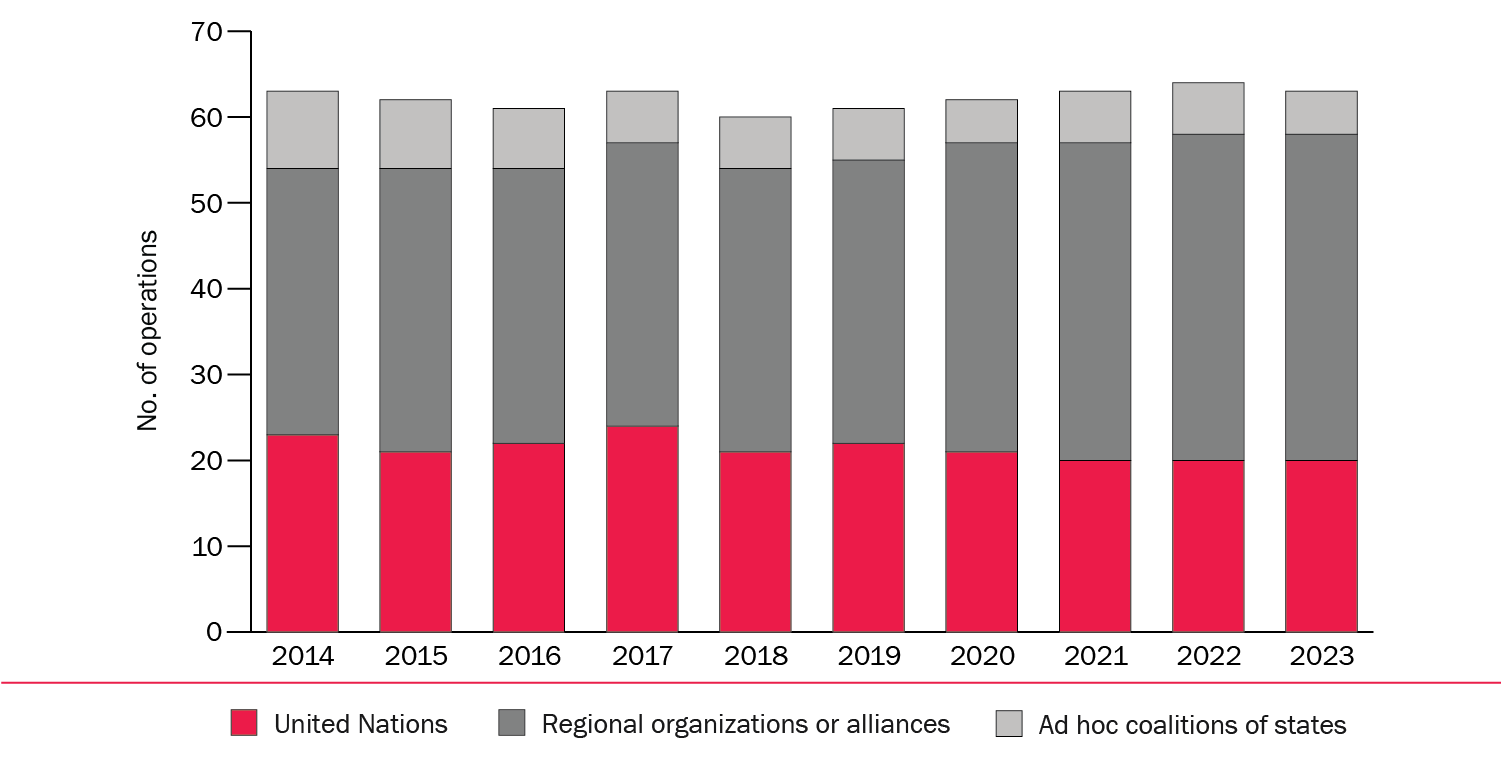3. Multilateral peace operations
Overview, Claudia Pfeifer Cruz, Jaïr van der Lijn, Timo Smit, Gretchen Baldwin and Marina Tovar
I. Global trends and developments in peace operations, Claudia Pfeifer Cruz, Timo Smit and Marina Tovar
II. Organizations conducting multilateral peace operations, Claudia Pfeifer Cruz, Timo Smit and Gretchen Baldwin
III. The way forward for multilateral peace operations, Jaïr van der Lijn
IV. Table of multilateral peace operations, 2023, Claudia Pfeifer Cruz and Timo Smit
There were 63 active peace operations in 2023—one fewer than in the previous year. Three started in 2023: the European Union (EU) Mission in Armenia (EUMA); the EU Partnership Mission in the Republic of Moldova (EUPM Moldova); and the Southern African Development Community (SADC) Mission in the Democratic Republic of Congo (SAMIDRC). Four closed in 2023: the United Nations Multidimensional Integrated Stabilization Mission in Mali (MINUSMA); the UN Integrated Transition Assistance Mission in Sudan (UNITAMS); the East African Community Regional Force in the Democratic Republic of the Congo (EACRF-DRC); and the African Union (AU) Military Observer Mission to the Central African Republic (MOUACA).
The number of personnel deployed to multilateral peace operations globally fell by 13 per cent during the year, dropping from 114 984 in December 2022 to 100 568 in December 2023. This was the largest annual decrease and lowest number of personnel deployed in the decade 2014–23. The drop in 2023 was mostly due to reductions in sub-Saharan Africa, where most peace operation personnel are deployed.
The UN continued to be the main organization deploying multilateral peace operations, accounting for about one third of all operations and 67 per cent of all personnel deployed as of December 2023. However, most peace operations were deployed by regional organizations and alliances, which led 38 multilateral peace operations in 2023—the same number as in 2022. Ad hoc coalitions of states conducted five multilateral peace operations in 2023, which was one fewer than in 2022. In addition, in 2023 there were several other multilateral operations that aimed to contribute to security and stability but were not classified by SIPRI as multilateral peace operations.
During 2023, a total of 45 international personnel and 15 local staff died while serving in UN multilateral peace operations, which was 41 fewer fatalities than in 2022 and the lowest number of fatalities among UN peacekeepers in the decade 2014–23.
Number of multilateral peace operations, by type of conducting organization, 2014–23
The shifting peace operations landscape
In 2023, three trends related to multilateral peace operations continued. First, broader geopolitical tensions continued to affect the political consensus on managing armed conflicts. Finding agreement on new operations or on adjustments to the mandates of existing operations proved difficult in the UN Security Council and in the AU Peace and Security Council. Second, there was growing dissatisfaction at the national level with existing peace operations, prompting discussions in host countries about their effectiveness and value. Third, the past few years have seen a shift away from UN-led operations and an increase in the number of operations deployed by regional organizations.
These trends point to four expected future developments. First, the polarization and lack of consensus in the UN Security Council and regional forums are resulting in inaction on conflict management by the international community. Second, the increasing use of private military and security companies and ad hoc or bilateral operations in conflict management, as an alternative to multilateral peace operations, suggests that conflict management is fragmenting. Third, conflict management decision making and implementation seem to be moving towards deinstitutionalization, meaning that they increasingly take place outside institutional frameworks. Fourth, there appears to be a development towards the further militarization and securitization of efforts to restore and maintain peace. These developments have the potential to significantly reshape the multilateral peace operations landscape.
